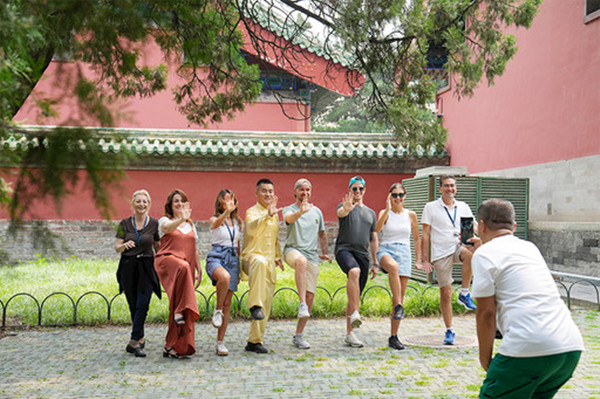


Foreign tourists’ viral videos present real image of China

Italian tai chi enthusiasts pose for a photo while visiting the Temple of Heaven in Beijing on July 9. Photo: XINHUA
Since the beginning of 2024, “China Travel” videos created by foreign tourists have frequently gone viral on short video platforms both domestically and internationally. These short videos capture the diverse experiences of foreign visitors in China, sparking keen interest in the country among international audiences and providing a glimpse of a dynamic and charming China.
Contrasting stereotyped image
Why have China travel videos drawn so much attention? This phenomenon is generally attributed to epistemological differences between people of different countries. Some of these differences originate from cultural backgrounds, while others are influenced by media.
For a long time, Western media’s reportage of China has been influenced with ideology and the Cold War-era mentality, often portraying the country as poor, underdeveloped, even dangerous and otherwise terrible, said Jin Yuanpu, director of the Institute of Cultural Creative Industries at Renmin University of China. In contrast, when foreign tourists travel around China, their short videos tend to showcase China from their perspective in a more faithful and simple manner, naturally attracting attention and piquing the curiosity of overseas netizens, Jin said.
As an increasing number of foreign tourists visit China, their short videos with distinct personal tags play a positive role in reducing communication barriers, dismantling the negative epistemological framework created by the West. They promote people-to-people exchanges between China and the rest of the world, providing new channels for cross-cultural communication and the overseas dissemination of Chinese culture.
Analyzing the video content, Chen Qiang, a professor from the School of Journalism and New Media at Xi’an Jiaotong University, observed that narrating China travel from a first-person perspective leverages the power of communication through scenarios and emotions. The authentic, exploratory, and amiable audiovisual language of these videos effectively reduces communication obstacles posed by textual descriptions, readily evoking resonance among overseas audiences.
Chen noted that these videos, primarily focused on basic travel needs, not only introduce viewers to China’s delicious cuisine and picturesque landscapes but also highlight the nation’s technological advancements, such as automated driving and drone delivery, providing a comprehensive and vivid portrayal of China’s rapid development.
In terms of language style, contrast and surprise feature prominently in the videos. Words like “China is different from what I imagined” constitute a powerful rebuttal to the negative epistemological framework that Western media have long propagated about China,
Chen continued. Regarding interactive experience, foreign tourists are better at harnessing the interactive advantage of social media to communicate with netizens. The warmth and hospitality of Chinese people shine through in these videos and their accompanying comments, cultivating a harmonious cross-cultural atmosphere.
Fueling cross-cultural communication
Along with the popularity of foreign tourists’ China travel videos is the wide acclaim of the “144-hour visa-free transit” policy, which has made it increasingly convenient for foreign tourists to visit and experience the real China. In fact, China introduced the “72/144-hour visa-free transit” policy as early as in 2013, which has now extends to 54 countries, with the number of cities and countries included set to grow.
China’s visa-free policy represents a significant communication phenomenon in enhancing international exchanges and fostering mutual learning among civilizations, said Huang Chuxin, secretary general of the New Media Research Center at the Chinese Academy of Social Sciences. Through the lens of communication, visa-free policies can be regarded as a medium for cross-cultural interaction. People-to-people exchanges of this kind effectively lower the threshold for bilateral communication, providing opportunities for people from different cultural backgrounds to understand each other more deeply.
Meanwhile, guerilla tourism has also become trendy among foreign travelers, who aim to visit multiple attractions within a short timeframe. Wu Chengzhong, director of the National Base for Cultural and Tourism Studies at the University of International Business and Economics, pointed out that China’s quick economic development and modernization have lent enormous support to tourism. In recent years, a sound high-speed railway network and modern public transportation in cities have enabled foreign tourists to easily explore China’s scenic landscapes, ensuring a fast and enjoyable travel experience.
In short videos produced by foreign tourists, terms like “safe,” “delicious,” “convenient,” and “modern” frequently appear as highlights. Wu stressed that the safe and stable environment of Chinese society is a key factor engaging foreigners, which not only enhances their satisfaction with the travel in China but also builds both trust and a favorable impression of the country.
Owing to modern infrastructure, a stable social environment, rich cultural resources, diverse food choices, convenient digital services, and open, inclusive visa policies, China’s appeal to foreign tourists is growing steadily. Through the sharing and communication of their own experiences, these inbound travelers have delivered a reliable, admirable, and respectable image of China to the world, Wu said.
Editor:Yu Hui
Copyright©2023 CSSN All Rights Reserved